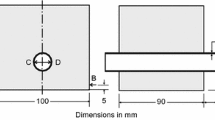Abstract
We studied the corrosion characteristics of reinforcing bars in concrete under different corrosion conditions. The area-box (AB) value was used to classify the shape of pitting corrosion morphology in meso-scale, and fractographs of reinforcing bars with different corrosion morphology were discussed in micro- and macro-scales. The results show that the existence of the tensile stress affects the corrosion characteristics of reinforcing bars. The pitting morphology and fractograph of reinforcing bars exhibit a statistical fractal feature. The linear regression model fits the relationship between fractal dimensions of corrosion morphology and fractal dimension of fractograph fairly well. Using fractal dimension as the characterization parameter can not only reflect the characteristics of pitting corrosion morphology in reinforcing bars, but also reveal the fracture feature of corroded reinforcing bars.
Similar content being viewed by others
References
Koleva D A, de Wit J H W, van Breugel K, et al. Correlation of Microstructure, Electrical Properties and Electrochemical Phenomena in Reinforced Mortar. Breakdown to Multi-Phase Interface Structures. Part II: Pore Network, Electrical Properties and Electrochemical Response[J]. Mater. Charact., 2008, 59(6):801–815
Koleva D A, van Breugel K, de Wit J H W, et al. Correlation of Microstructure, Electrical Properties and Electrochemical Phenomena in Reinforced Mortar. Breakdown to Multi-Phase Interface Structures. Part I: Microstructural Observations and Electrical Properties[J]. Mater. Charact., 2008,59(3):290–300
Saremi M, Mahallati E. A Study on Chloride-Induced Depassivation of Mild Steel in Simulated Concrete Pore Solution[J]. Cem. Concr. Res., 2002,32(12):1 915–1 921
Yuan Y S, Ji Y S. Modeling Corroded Section Configuration of Steel Bar in Concrete Structure[J]. Constr. Build. Mater., 2009, 23(6): 2 461–2 466
Almusallam A A. Effect of Degree of Corrosion on the Properties of Reinforcing Steel Bars[J]. Constr. Build. Mater., 2001,15(8):361–368
Du Y G, Clark L A, Chan A H C. Residual Capacity of Corroded Reinforcing Bars[J]. Mag. Concr. Res., 2005,57(3):135–147
Jaffer S J, Hansson C M. Chloride-Induced Corrosion Products of Steel in Cracked-Concrete Subjected to Different Loading Conditions[J]. Cem. Concr. Res., 2009,39(2):116–125
Ahn W, Reddy D V. Galvanostatic Testing for the Durability of Marine Concrete under Fatigue Loading[J]. Cem. Concr. Res., 2001,31(3):343–349
Apostolopoulos C A, Papadopoulos M P, Pantelakis S G. Tensile Behavior of Corroded Reinforcing Steel Bars BSt 500(s)[J]. Constr. Build. Mater., 2006,20(9):782–789
Papadakis V G, Apostolopoulos C A. Consequences of Steel Corrosion on the Ductility Properties of Reinforcement Bar[J]. Constr. Build. Mater., 2008,22(12): 2 316–2 324
Mandelbrot B B, Passoja D E, Paullay A J. Fractal Character of Fracture Surfaces of Metals[J]. Nature, 1984,308(5 961):721–722
Costa J M, Sagués F, Vilarrasa M. Fractal Patterns from Corrosion Pitting[J]. Corros. Sci., 1991,32(5–6):665–668
Azevedo C R F, Marques E R. Three-Dimensional Analysis of Fracture, Corrosion and Wear Surfaces[J]. Eng. Fail. Anal., 2010,17(1):286–300
Codaro E N, Nakazato R Z, Horovistiz A L, et al. An Image Processing Method for Morphology Characterization and Pitting Corrosion Evaluation[J]. Mat. Sci. Eng. A-Struct., 2002,334(1–2):298–306
Silva J W J, Bustamante A G, Codaro E N, et al. Morphological Analysis of Pits Formed on Al 2024-T3 in Chloride Aqueous Solution[J]. Appl. Surf. Sci., 2004,236(1–4):356–365
Charkaluk E, Bigerelle M, Iost A. Fractals and Fracture[J]. Eng. Fract. Mech., 1998, 61(1):119–139
Parrington R J. Fractography of Metals and Plastics[J]. Plast. Eng., 2000,56(12):54–59
Zhang Z L, Thaulow C, Odegard J. A Complete Gurson Model Approach for Ductile Fracture[J]. Eng. Fract. Mech., 2000,67(2):155–168
Author information
Authors and Affiliations
Corresponding author
Additional information
Funded by 973 Program (No.2009CB623200), National Natural Science Foundation of China (No.51008276), Ningbo Scientific and Technological Innovation Team (No.2011B81005) and Ningbo Natural Science Foundation (No.2011A610075)
Rights and permissions
About this article
Cite this article
Xu, Y., Qian, C. Influence of coupled chemo-mechanical process on corrosion characteristics in reinforcing bars. J. Wuhan Univ. Technol.-Mat. Sci. Edit. 28, 538–543 (2013). https://doi.org/10.1007/s11595-013-0727-0
Received:
Accepted:
Published:
Issue Date:
DOI: https://doi.org/10.1007/s11595-013-0727-0




